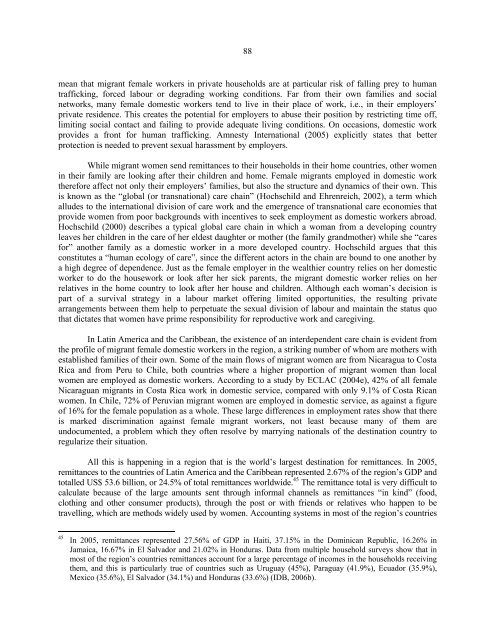Women in Latin America and the Caribbean - Cepal
Women in Latin America and the Caribbean - Cepal
Women in Latin America and the Caribbean - Cepal
Create successful ePaper yourself
Turn your PDF publications into a flip-book with our unique Google optimized e-Paper software.
88<br />
mean that migrant female workers <strong>in</strong> private households are at particular risk of fall<strong>in</strong>g prey to human<br />
traffick<strong>in</strong>g, forced labour or degrad<strong>in</strong>g work<strong>in</strong>g conditions. Far from <strong>the</strong>ir own families <strong>and</strong> social<br />
networks, many female domestic workers tend to live <strong>in</strong> <strong>the</strong>ir place of work, i.e., <strong>in</strong> <strong>the</strong>ir employers’<br />
private residence. This creates <strong>the</strong> potential for employers to abuse <strong>the</strong>ir position by restrict<strong>in</strong>g time off,<br />
limit<strong>in</strong>g social contact <strong>and</strong> fail<strong>in</strong>g to provide adequate liv<strong>in</strong>g conditions. On occasions, domestic work<br />
provides a front for human traffick<strong>in</strong>g. Amnesty International (2005) explicitly states that better<br />
protection is needed to prevent sexual harassment by employers.<br />
While migrant women send remittances to <strong>the</strong>ir households <strong>in</strong> <strong>the</strong>ir home countries, o<strong>the</strong>r women<br />
<strong>in</strong> <strong>the</strong>ir family are look<strong>in</strong>g after <strong>the</strong>ir children <strong>and</strong> home. Female migrants employed <strong>in</strong> domestic work<br />
<strong>the</strong>refore affect not only <strong>the</strong>ir employers’ families, but also <strong>the</strong> structure <strong>and</strong> dynamics of <strong>the</strong>ir own. This<br />
is known as <strong>the</strong> “global (or transnational) care cha<strong>in</strong>” (Hochschild <strong>and</strong> Ehrenreich, 2002), a term which<br />
alludes to <strong>the</strong> <strong>in</strong>ternational division of care work <strong>and</strong> <strong>the</strong> emergence of transnational care economies that<br />
provide women from poor backgrounds with <strong>in</strong>centives to seek employment as domestic workers abroad.<br />
Hochschild (2000) describes a typical global care cha<strong>in</strong> <strong>in</strong> which a woman from a develop<strong>in</strong>g country<br />
leaves her children <strong>in</strong> <strong>the</strong> care of her eldest daughter or mo<strong>the</strong>r (<strong>the</strong> family gr<strong>and</strong>mo<strong>the</strong>r) while she “cares<br />
for” ano<strong>the</strong>r family as a domestic worker <strong>in</strong> a more developed country. Hochschild argues that this<br />
constitutes a “human ecology of care”, s<strong>in</strong>ce <strong>the</strong> different actors <strong>in</strong> <strong>the</strong> cha<strong>in</strong> are bound to one ano<strong>the</strong>r by<br />
a high degree of dependence. Just as <strong>the</strong> female employer <strong>in</strong> <strong>the</strong> wealthier country relies on her domestic<br />
worker to do <strong>the</strong> housework or look after her sick parents, <strong>the</strong> migrant domestic worker relies on her<br />
relatives <strong>in</strong> <strong>the</strong> home country to look after her house <strong>and</strong> children. Although each woman’s decision is<br />
part of a survival strategy <strong>in</strong> a labour market offer<strong>in</strong>g limited opportunities, <strong>the</strong> result<strong>in</strong>g private<br />
arrangements between <strong>the</strong>m help to perpetuate <strong>the</strong> sexual division of labour <strong>and</strong> ma<strong>in</strong>ta<strong>in</strong> <strong>the</strong> status quo<br />
that dictates that women have prime responsibility for reproductive work <strong>and</strong> caregiv<strong>in</strong>g.<br />
In Lat<strong>in</strong> <strong>America</strong> <strong>and</strong> <strong>the</strong> <strong>Caribbean</strong>, <strong>the</strong> existence of an <strong>in</strong>terdependent care cha<strong>in</strong> is evident from<br />
<strong>the</strong> profile of migrant female domestic workers <strong>in</strong> <strong>the</strong> region, a strik<strong>in</strong>g number of whom are mo<strong>the</strong>rs with<br />
established families of <strong>the</strong>ir own. Some of <strong>the</strong> ma<strong>in</strong> flows of migrant women are from Nicaragua to Costa<br />
Rica <strong>and</strong> from Peru to Chile, both countries where a higher proportion of migrant women than local<br />
women are employed as domestic workers. Accord<strong>in</strong>g to a study by ECLAC (2004e), 42% of all female<br />
Nicaraguan migrants <strong>in</strong> Costa Rica work <strong>in</strong> domestic service, compared with only 9.1% of Costa Rican<br />
women. In Chile, 72% of Peruvian migrant women are employed <strong>in</strong> domestic service, as aga<strong>in</strong>st a figure<br />
of 16% for <strong>the</strong> female population as a whole. These large differences <strong>in</strong> employment rates show that <strong>the</strong>re<br />
is marked discrim<strong>in</strong>ation aga<strong>in</strong>st female migrant workers, not least because many of <strong>the</strong>m are<br />
undocumented, a problem which <strong>the</strong>y often resolve by marry<strong>in</strong>g nationals of <strong>the</strong> dest<strong>in</strong>ation country to<br />
regularize <strong>the</strong>ir situation.<br />
All this is happen<strong>in</strong>g <strong>in</strong> a region that is <strong>the</strong> world’s largest dest<strong>in</strong>ation for remittances. In 2005,<br />
remittances to <strong>the</strong> countries of Lat<strong>in</strong> <strong>America</strong> <strong>and</strong> <strong>the</strong> <strong>Caribbean</strong> represented 2.67% of <strong>the</strong> region’s GDP <strong>and</strong><br />
totalled US$ 53.6 billion, or 24.5% of total remittances worldwide. 45 The remittance total is very difficult to<br />
calculate because of <strong>the</strong> large amounts sent through <strong>in</strong>formal channels as remittances “<strong>in</strong> k<strong>in</strong>d” (food,<br />
cloth<strong>in</strong>g <strong>and</strong> o<strong>the</strong>r consumer products), through <strong>the</strong> post or with friends or relatives who happen to be<br />
travell<strong>in</strong>g, which are methods widely used by women. Account<strong>in</strong>g systems <strong>in</strong> most of <strong>the</strong> region’s countries<br />
45<br />
In 2005, remittances represented 27.56% of GDP <strong>in</strong> Haiti, 37.15% <strong>in</strong> <strong>the</strong> Dom<strong>in</strong>ican Republic, 16.26% <strong>in</strong><br />
Jamaica, 16.67% <strong>in</strong> El Salvador <strong>and</strong> 21.02% <strong>in</strong> Honduras. Data from multiple household surveys show that <strong>in</strong><br />
most of <strong>the</strong> region’s countries remittances account for a large percentage of <strong>in</strong>comes <strong>in</strong> <strong>the</strong> households receiv<strong>in</strong>g<br />
<strong>the</strong>m, <strong>and</strong> this is particularly true of countries such as Uruguay (45%), Paraguay (41.9%), Ecuador (35.9%),<br />
Mexico (35.6%), El Salvador (34.1%) <strong>and</strong> Honduras (33.6%) (IDB, 2006b).











